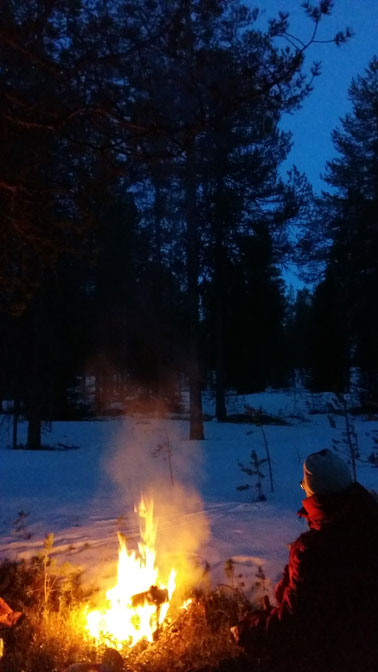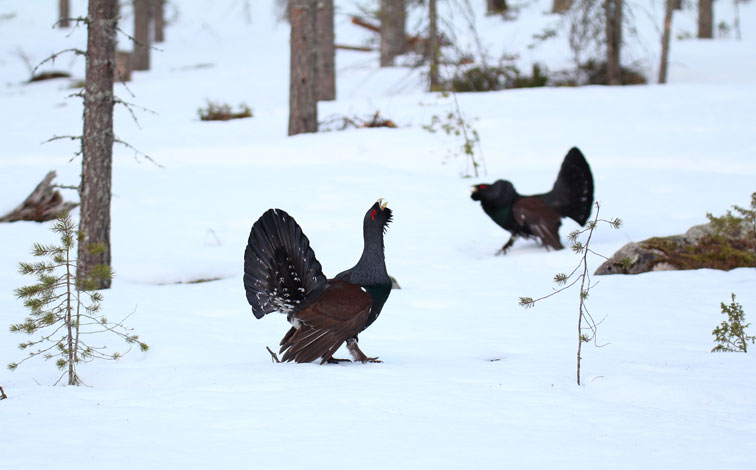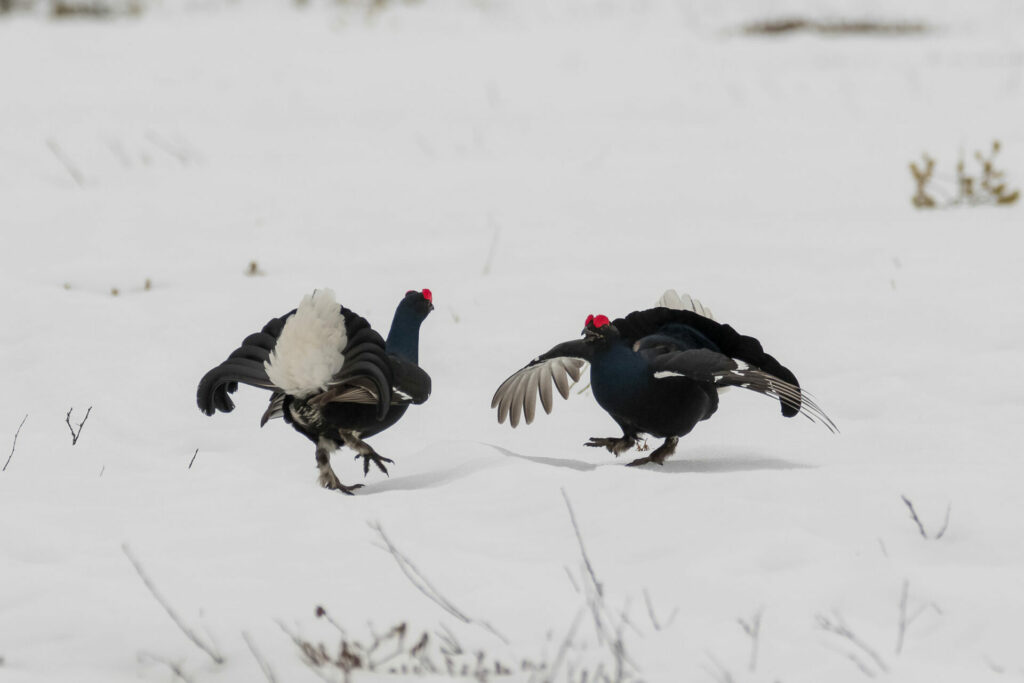Witnessing a gathering of capercaillies in the dark
(Teksti suomeksi löytyy blogin lopusta)
Around midnight, towards the end of April, there’s a few hours of darkness in the forest. I’m gawking at the young saplings, barely discernible against the dark night sky.
A familiar grove of old spruce trees, to which I skied in the evening to witness the capercaillie lekking, has disappeared from around me. I realise I’ve lost the sense of direction in the darkness.
– Well what do you know, here we are then, lost in the dark forest. Darn!
How foolish of me to rush off now like that!

Primeval spruce forest.
In early spring, my family has had the habit of going out to the forest to watch the capercaillie courtship ritual. Around the first of May, on some windless evening, we would pack a campfire kettle, some coffee, matches and warm clothes into a knapsack and head towards the uninhabited wilderness.
We ski to the lek early in the evening, make a fire deep in between the spruce trees not far from the site where the capercaillies were known to gather. There by the fire, sitting on deadwood logs we wait for the night to tick away, sipping coffee, telling stories. Pricking up our ears to hear if the capercaillie will arrive flying to the lek.

We spend the dead of the night keeping up the fire, because during the wee hours, right after dawn, the lekking is at its best. It is then worth tip-toeing closer to see how the male birds fight to win over the female capercaillies gathered in the area.
The nightly forest is very quiet and mysterious. You may hear a few song thrushes chirp in the early evening, and once the darkness falls, a willow ptarmigan bleats by the side of the slough but then becomes quiet and goes to sleep. The fire crackles and crinkles, and the snow around it sizzles as it melts
Waiting for the dawn to break, we try to get some sleep. Usually to no avail, with the coldness emanating from the surrounding snowdrifts. In April, the temperature usually drops below the freezing point at night.
Around two or three in the morning, the dawn slowly starts to light up the spruces. Then it’s time to hop on our skis and head towards the lek, where the male capercaillie are making noises. You have to move nimbly: Only when they are making noises, which sound like grinding, are you allowed to move closer. Otherwise you have to be still and try to remain perfectly silent.

Capercaillie male birds. Photo©Reijo Kuosmanen.
At best, you may manage to get under the same tree with a bird. So I have heard, anyway. As for me, I was content to see the capercaillie lark about on the snow from a distance. I did my first trips to the lek as a young girl in the 1970’s. At that time, we knew the bird population was very low, so I did not want to cause any unnecessary disturbance in their habitat. As long as I could be there in the nightly forest and sense the atmosphere, that was enough.
In recent years, the cultural characteristics of Forest Lapland have been surveyed from the viewpoint of the Forest Lapps themselves. The study has shed light on the close relationship the Forest Lapps have with nature and the year cycle, and also with the related habits in reindeer husbandry, hunting, fishing and berry-picking1. The study concludes that “the Forest Lapps have a collective understanding that one must not exploit nature but take only what is necessary”.
My family’s visits to the capercaillie lek have been part of this yearly cycle, one of the activities that have taught us to understand the habits of the different species, and to recognise their habitats from early on. Apart from these visits, alongside everyday chores, we would also follow the population dynamics of the fowl throughout the year.
As we travelled on foot to our berry-picking grounds or to wilderness lakes to fish, broods of birds would take wing and disappear in the nearby forest, and that’s how we quickly learned to tell which species it was and how big the flock was. In winter, we would estimate and memorise the size of the black grouse flocks feeding among the birches by the river shore.
We gradually gained knowledge and quite a precise idea of the nesting outcome as well as the size and development of the population. Come autumn, and this knowledge became handy during hunting season: We knew how much prey we could take without going overboard, because one must not be greedy when taking nature’s gifts!
In my opinion, a strong knowledge of the prey species is part of the wisdom tradition that Tero Mustonen, a climate scientist and one of the co-writers of the recent IPCC report, referred to in his interview2 in Helsingin Sanomat, when he talked about the traditional primary economic activities. ”It is a wisdom tradition, of which the idea of moderation is also an inherent part. It has a lesson to teach us all.”
In the prevention of climate change, Mustonen encourages us to take action and maintain the cultures pertaining to the northern livelihoods, saying, ”Now is not the time to give up but to step on it” and ”the global change is drastic but the traditional primary economic activities will help the local communities to survive.”
On a global scale, it is widely acknowledged that ecological traditional knowledge is an important part of environmental protection3. Such traditional knowledge refers to the native people’s knowledge of nature and their culture, which is often passed on from generation to generation either orally or in a written form, for example as stories, songs and myths or through habits and practices. Now this knowledge is considered to play a pivotal role in the fight against climate change4.
As a cultural tradition, I am extremely grateful that from a very early age I was taken out to sleep under a spruce tree, learn the forest’s ways and listen to nature’s voices. I continued my nightly spring visits to the familiar lek in Eastern Lapland by myself up until the 2016 loggings in the area.
Whether this tradition will continue after me is uncertain, as my own children and grandchildren are no longer living in an environment close to nature. The forest no longer plays as an important part in everyday activities as it did for my generation. The modern age has done its deed. I also grieve how much knowledge and skills disappeared from the world along with my parents’ generation.
In my thoughts every spring, I still ski to that very same spruce forest where the capercaillie performed their courtship rituals. I sit there waiting for the dawn to break, listening to the wind humming up in the branches. Wondering what sort of forest folk have gathered around the fire this time.
* * *
– Lost! NO WAY!
I abruptly stop skiing. I better not go any further or else I will wander even more astray. I feel, however, relatively secure and safe:
-I’m in my own forest, after all, not to worry…
There, standing in the dark, my thoughts calm down. I decide to wait right there for an hour and not move until dawn.
Suddenly, I feel a light gust of wind on my face. And from the darkness I begin to hear the babbling of a black grouse. I realise that the wind direction must be the same as it was early in the evening, in other words, the wind is from the south. And this lonely black grouse is making noises in the same slough as a few hours earlier when I was still sitting by the fire. So, the bird is in the south-west direction.
-Thank you, black grouse!
From here, I think I’ll manage by myself just fine…!

Black grouses. Photo©Kari Heljasvaara.
Sources:
2Jään varassa. Ilmastotutkija Tero Mustosen haastattelu, Helsingin Sanomat 19.2.2022.
3Tradiotional knowledge. Arctic Centre, University of Lapland.
Text ©Kaisa Kerätär
Photos by Kaisa Kerätär if not mentioned otherwise.
Translation by NorthLing.
OMASSA METTÄSSÄ
Huhtikuun lopulla keskiyöllä vallitsee metsässä muutaman tunnin mittainen pimeys. Töllistelen ympäröivää nuorta taimikkoa, joka kiippis-kaappis erottuu tummaa yötaivasta vasten.
Tuttu kuusikko, jonne hiihdin iltasella metsonsoitimelle, on hävinnyt ympäriltäni. Tajuan, että pimeässä en pysty enää erottamaan ilmansuuntia.
– No-n-ni!! Täällä sitä nyt ollaan, eksyksissä pimeässa metsässä. Pahus..!
Pitikin hosua ja lähteä liikkeelle!
Alkukeväällä on perheessäni ollut tapana käydä metsonsoitimella. Vapun tienoolla, jonakin tuulettomana iltana pakataan nuotiopannu, kahvia, tulentekovälineet ja lämmintä vaatetta reppuun, ja suunnataan kulku asumattomaan kairaan.
Soidinpaikalle hiihdetään alkuillasta, tehdään tulet kuusikon kätköön vähän matkan päähän paikasta, johon metsojen tiedetään aina kokoontuvan. Siinä nuotion äärellä, kelotukeilla istuen odotetaan yön kulumista, kahvitellaan ja tarinoidaan niitä näitä. Kuulostellaan saapuisiko metsoja lentäen soidinpaikalle.
Tulistellen vietetään yön pimeimmät hetket, sillä aamuyön tunteina, heti valoisan tultua, soidin on parhaimmillaan. Silloin voi hiipiä lähemmäs katsomaan, kun metsokukot kamppailivat alueelle kerääntyneiden naaraiden suosiosta.
Öisessä metsässä on hyvin hiljaista ja salaperäistä. Muutama varhainen laulurastas lurittelee ehkä alkuillasta, ja hämärän tultua riekko päkättää rämeen laidalla, mutta hiljenee ja asettuu sitten yöunille. Nuotio paukkuu ja kahisee, ja lumi sen ympärillä sihisee sulaessaan.
Aamun valkenemista odottaessa koetetaan saada unta. Harvemmin sitä tulee nukuttua, sillä kylmä hohkaa ympärillä olevista kinoksista. Huhtikuussa lämpötila laskee öisin yleensä pakkasen puolelle.
Aamuyöllä kahden-kolmen maissa valo alkaa hitaasti lisääntyä kuusikossa. Silloin hiihdetään kohti ukkometsojen ääntelyä niiden soidinreviirille. Liikkumisessa on oltava näppärä: vain metson hiomiselta kuulostavan ääntelyn aikana saa edetä lähemmäs, muutoin pitää pysähtyä ja yrittää olla ihan hiljaa.
Parhaimmillaan soitimella saattaa onnistua pääsemään linnun kanssa saman puun alle, näin olen kuullut kerrottavan. Itselleni riitti aina se, että näin metsojen juoksentelevan etäällä hangella. Ensimmäisiä soidinretkiä tein nuorena tyttöihmisenä 1970 -luvulla. Silloin lintukantojen tiedettiin olevan hyvin alhaalla, joten en halunnut aiheuttaa yhtään ylimääräistä häiriötä niiden elinympäristössä. Pääasia oli olla öisessä metsässä, ja aistia sen tunnelmaa.
Metsä-Lapin kulttuurisia erityispiirteitä on viime vuosina kartoitettu metsälappalaisen väestön omasta näkökulmasta. Selvityksessä on noussut esiin Metsä-Lapin asukkaiden tiivis suhde luontoon ja vuodenkiertoon sekä siihen liittyvät tavat poronhoidossa, metsästyksessä, kalastuksessa ja marjastuksessa1. Johtopäätöksenä todetaan, että ’metsälappalaisilla on kollektiivinen ymmärrys siitä, ettei luontoa voi riistää ja sieltä on otettava vain tarpeellinen.
Omassa perheessäni metson soitimella käynti on ollut eräs osa tällaista vuotuiskiertoa, yksi niistä aktiviteeteista, joiden yhteydessä on nuoresta pitäen harjaannuttu ymmärtämään eri lajien elintapoja, ja tunnistamaan niiden elinympäristöjä. Soitimella käynnin lisäksi seurasimme riistalintujen kannanvaihtelua pitkin vuotta muiden arjen toimien ohessa.
Kulkiessamme jalkaisin kesän marja-apajille tai kalastamaan erämaalammille lintupoikueita lehahti lentoon ja kaikkosi kulkureitiltä lähimaastoon, jolloin oppi nopeasti määrittämään mikä laji oli kyseessä ja kuinka suuresta parvesta oli kyse. Talvisin jokivarren rantakoivikoissa ruokailevien teeritokkien kokoa arvioitiin ja painettiin mieleen.
Vähitellen kertyi tietoa ja muodostui tarkka käsitys eri lajien pesimistuloksesta sekä kannan koosta ja kehityksestä. Syksyn tultua tuolle populaatiotason tiedolle oli käyttöä metsästysaikana: osattiin ottaa tarvittava määrä saalista, mutta ei ylittää kohtuutta, sillä pyytöhommissa ei sopinut ahnehtia!
Saalislajien hyvä tuntemus on mielestäni sitä viisausperinnettä, johon Tero Mustonen, ilmastotutkija ja kansainvälisen ilmastopaneelin IPCC:n tuoreen raportin yksi kirjoittajista viittasi Helsingin Sanomien haastattelussa2 puhuessaan perinteisistä luontaiselinkeinoista. ”Se on viisausperinnettä, johon kuuluu myös kohtuuden käsite. Siitä pitäisi ottaa oppia.”
Ilmastomuutoksen torjunnassa Mustonen kannustaa käytännön toimiin ja pohjoisen elinkeinoihin liittyvien kulttuurien ylläpitämiseen todeten: ”Nyt ei ole aika luovuttaa vaan painaa kaasua” ja ”Globaali muutos on raju, mutta perinteiset luontaiselinkeinot auttavat paikallisyhteisöjä selviytymään.”
Maailmalla on laajalti ymmärretty, että ekologinen perinnetieto on tärkeä osa ympäristönsuojelua3. Tällaisella perinnetiedolla tarkoitetaan alkuperäiskansojen tietämystä luonnosta ja heidän kulttuuristaan, tietoa, joka siirtyy usein perimätietona sukupolvelta toiselle joko suullisesti tai kirjallisesti, esimerkiksi tarinoina, lauluina ja myytteinä taikka käytännön ja kokemuksen kautta. Nyt tämän tiedon nähdään olevan merkittävässä osassa ilmastonmuutoksen vastaisessa taistelussa4.
Kulttuurisena traditiona arvostan kovasti sitä, että minut on viety lapsesta lähtien kuusen juurelle yöpymään, oppimaan metsän tavoille ja luonnon ääniä kuuntelemaan. Olen jatkanut itsekseni kevätöisiä soitimella käyntejä tutulla soidinpaikalla Itä-Lapissa aina siihen asti, kun alueella tehtiin metsähakkuita vuonna 2016.
Perinteen jatkuminen on omalla kohdallani epävarmaa, sillä omat lapset ja lapsenlapset eivät enää elä sellaisessa ympäristössä, jossa ollaan tiiviisti lähellä luontoa. Metsä ei ole enää jälkipolville niin suuri osa arjen toimintaympäristöä kuin minun sukupolvelleni. Moderni aika on tehnyt tehtävänsä. Suren myös sitä kuinka paljon tietoa ja taitoja hävisi maailmasta vanhempieni sukupolven myötä.
Ajatuksissani hiihtelen yhä joka kevät tuolle samalle metsonsoidinkuusikolle. Istuskelen odottamassa aamun valkenemista, kuuntelen tuulta oksistossa. Mietin, minkälaista metsänväkeä tällä kertaa on nuotiotulen äärelle kertynyt.
* * *
– Eksyksissä! EIKÄ!
Pysäytän hiihtämisen siihen paikkaan. Nyt ei parane edetä yhtään pidemmälle tai muuten kulkeutuisin yhä enemmän harhaan. Koen olevani kuitenkin suhteellisen turvassa:
-Omissa metsissähän tässä ollaan…’
Pimeässä seisoskellessa ajatukseni rauhoittuvat. Päätän odottaa niillä sijoillani seuraavan tunnin, ja edetä vasta valoisan tultua.
Samalla tunnen kevyen tuulenpuuskan kasvoillani. Ja pimeästä alkaa kuulua teerenpulinaa. Oivallan, että tuulensuunta täytyy olla sama kuin alkuillasta eli tuulee etelästä. Ja yksinäinen teeri ääntelee samalla rämeellä kuin muutama tunti aiemmin istuessani nuotiolla. Lintu on siis lounaan suunnalla.
-Kiitos teeri!
Tästäpä miä seleviänki jo sitte ite..!”




